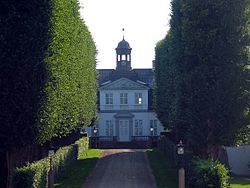Sorgenfri Palace
| Sorgenfri Palace | |
|---|---|
| Sorgenfri Slot | |

Sorgenfri Palace
|
|
| General information | |
| Type | Palace |
| Architectural style | Baroque |
| Town or city | Kongens Lyngby |
| Country | Denmark |
| Coordinates | 55°46′44″N 12°29′49″E / 55.77889°N 12.49694°E |
| Construction started | 1756 |
| Completed | 1757 |
| Client | Dowager Princess Sophie Caroline of East Frisia |
| Design and construction | |
| Architect | Lauritz de Thurah |
Sorgenfri Palace (Danish: Sorgenfri Slot; lit. "carefree", a direct calque of ) is a royal residence of the Danish monarch, located in Lyngby-Taarbæk Municipality, on the east side of Lyngby Kongevej, in the northern suburbs of Copenhagen. The surrounding neighbourhood is called Sorgenfri after it. Only the celler and foundations survive of the first Sorgenfri House, which was built in 1705 to design by François Dieussart. The current house was built in 1756 by Lauritz de Thurah and later adapted and extended by Peter Meyn in the 1790s. Lauritz de Thurah has also designed buildings which flank the driveway closer to the road.
Sprgenfri Palace is surrounded by a large park which is bounded by Mølleåen to the east. It was adapted to the English Romantic style in the late 1790s and early 1899s and contains several small buildings.
Christian X used it as a summer residence and it has later been part of it let out to relatives of the royal family. The park is open to the public.
Sorgenfri Palace is located at the site of a medieval settlement, Mølletorp, which was owned by the Bishopric of Roskilde but confiscated by the crown during the Reformation in the 1530s. In 1686, it was replaced by a country house by High Court Justice Michael Vibe.
Count Carl von Ahlefeldt acquired the estate in 1702. He commissioned the architect François Dieussart to build a new summer residence at the site and renamed it Sorgenfri. The building, a half-timbered, three-winged complex in Baroque style, was completed in 1705. The central wing contained a banquet hall with double high cailings. Passage between the two residential side wings was therefore only possible at the ground floor.
King Christian VI acquired the estate in 1730. His son, Crown Prince Frederick, the later King Frederick V, used it as summer residence from 1742. The building was refurbished by Lauritz de Thurah who also constructed new stables and a new wing for the gentlemen of the Court.
...
Wikipedia
